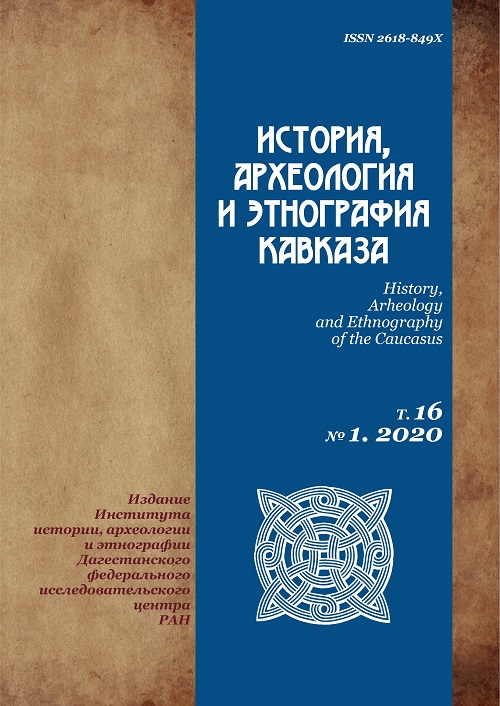К ИСТОРИИ РАЗВИТИЯ ОБРАЗОВАНИЯ У НОГАЙЦЕВ СЕВЕРНОГО КАВКАЗА (XVIII–ХХ ВВ.)
- Авторы: Гимбатова М.Б., Зинеева З.З.
- Выпуск: Том 16, № 1 (2020)
- Страницы: 145-156
- URL: https://caucasushistory.ru/2618-6772/article/view/1584
- DOI: https://doi.org/10.32653/CH161145-156
Аннотация
Статья посвящена одному из недостаточно изученных в исторической науке вопросу – становлению и развитию образования у ногайцев. Актуальность исследования по данной теме обусловлена значением образования как базового компонента духовной культуры этноса, нацеленностью результатов исследования на содействие культурному росту современных ногайцев, сохранению ими этнокультурной идентичности, укреплению этнического самосознания. Методологической и теоретической основой исследования является принцип историзма, а также историко-сравнительный и историко-типологический методы. С помощью новых архивных документов, впервые вводимых в научный оборот, и полевых материалов выделены этапы народного образования ногайцев: дореволюционный (досоветский), советский и постсоветский. С принятием ислама ногайцами приблизительно в 1254–1256 гг. в Ногайской степи возникает целая сеть мектебов и медресе, в которых изучались основы ислама, арабская письменность и словесность, произведения передовой научной мысли и литературы Востока. С включением территорий с ногайским населением в состав Российской империи открываются светские школы, училища и гимназии, в которых благодаря влиянию прогрессивной русской культуры ногайцы познакомились с достижениями мировой культуры и влились в общероссийское культурное поле. В XIX в. из среды получивших образование ногайцев вышли литераторы, просветители и общественные деятели, высоко зарекомендовавшие себя не только в России, но и в странах Ближнего Востока. С установлением Советской власти в стране неграмотность среди ногайцев была ликвидирована. Появление национальных школ и учителей родного языка послужило становлению советской ногайской интеллигенции. Важнейшей ее заслугой стало создание новой ногайской письменности, ее современной литературной формы, учебной и справочной литературы на ногайском языке. Сделан вывод, что народное образование ногайцев, пройдя определенные этапы в своем становлении и развитии, вышло на новый качественный уровень, соответствующий требованиям российской образовательной системы.
Мадина Багавутдиновна Гимбатова
Институт истории, археологии и этнографии Дагестанского федерального исследовательского центра РАН
Автор, ответственный за переписку.
Email: gimbatova@list.ru
ORCID iD: 0000-0002-6767-4478
SPIN-код: 4558-0275
Россия, 367030, Махачкала, М. Ярагского, 75
доктор исторических наук,
ведущий научный сотрудник отдела этнографии
Заида Залимхановна Зинеева
Карачаево-Черкесский институт гуманитарных исследований при Правительстве КЧР
Email: zineeva_zaida@mail.ru
SPIN-код: 2055-1654
Россия, Черкесск, Россия
к.и.н,
ведущий научный сотрудник
- 1. Георги И.Г. Описание всех обитающих в Российском государстве народов... СПб., 1799. Ч. 2. – 178 с.
- 2. Бентковский И.В. Историко-статистическое обозрение инородцев-магометан, кочующих в Ставропольской губернии. Ногайцы. Ставрополь, 1883. Ч. 1. – 134 с.
- 3. Калмыков И.Х., Керейтов Р.Х., Сикалиев А.И.-М. Ногайцы. Историко-этнографический очерк. Черкесск, 1988. – 232 с.
- 4. Перетяткович Г. Поволжье в XV и XVI веках. М., 1877. – 47 с.
- 5. Ананьев Г. Караногайцы, их быт и образ жизни // СМОМПК. Тифлис, 1894. Вып. 20. С. 36–63.
- 6. Анастасиев А. О татарских духовных школах // Русская школа. 1893. № 12. С. 126–137.
- 7. Уйсембаев А. Развитие религиозного и светского образования в Ногайской степи на рубеже XIX – XX вв. // Ногайцы: XXI век. История. Язык. Культура. От истоков – к грядущему. Черкесск, 2016. С. 104–109.
- 8. Сергеев А. Ногайцы на Молочных водах // Известия Таврической ученой архивной комиссии. Симферополь, 1912. № 48. С. 5–46.
- 9. Хрох М. Ориентация в типологии // Ab Imperio. 2000. № 2. С. 15.
- 10. Кемпинский Э.В. Российская интеллигенция: история и судьбы (региональное северокавказское исследование). М.: Соц.-полит. мысль, 2005. – 270 с.
- 11. Курмансеитова А.Х. Бытование арабописьменной книги у ногайцев // Современный быт и культура народов Карачаево-Черкесии. Вып. 3. Черкесск, 1990. С. 161–180.
- 12. Идрисов Ю.М. Краткий обзор материалов по истории ногайцев в XIX – начале XX вв., выявленных в дагестанских архивах // Ногайцы: XXI век. История. Язык. Культура. От истоков – к грядущему. Черкесск, 2016. С. 24–26.
- 13. Народы Дагестана / Под ред. С.А. Арутюнова, А.И. Османова, Г.А. Сергеева. М.: Наука, 2002. – 588 с.









